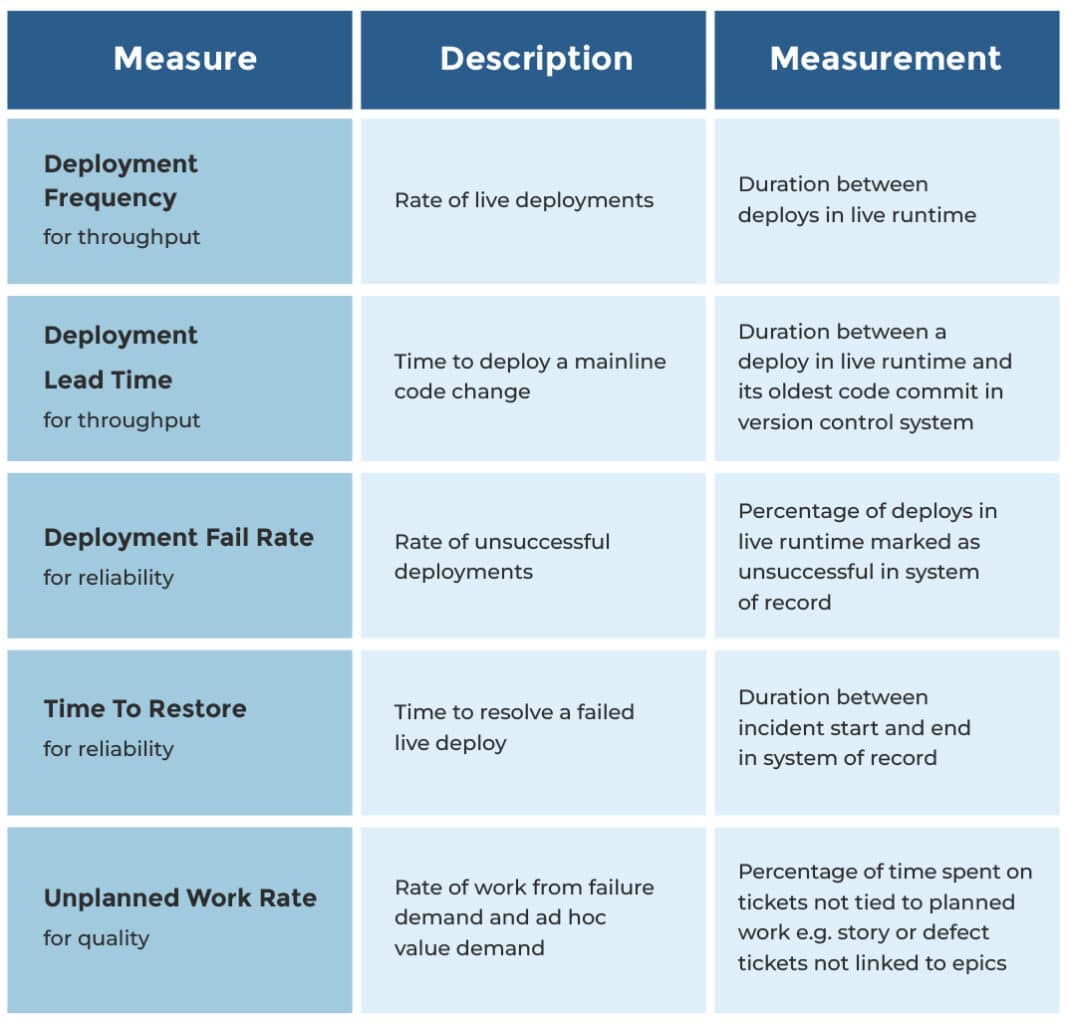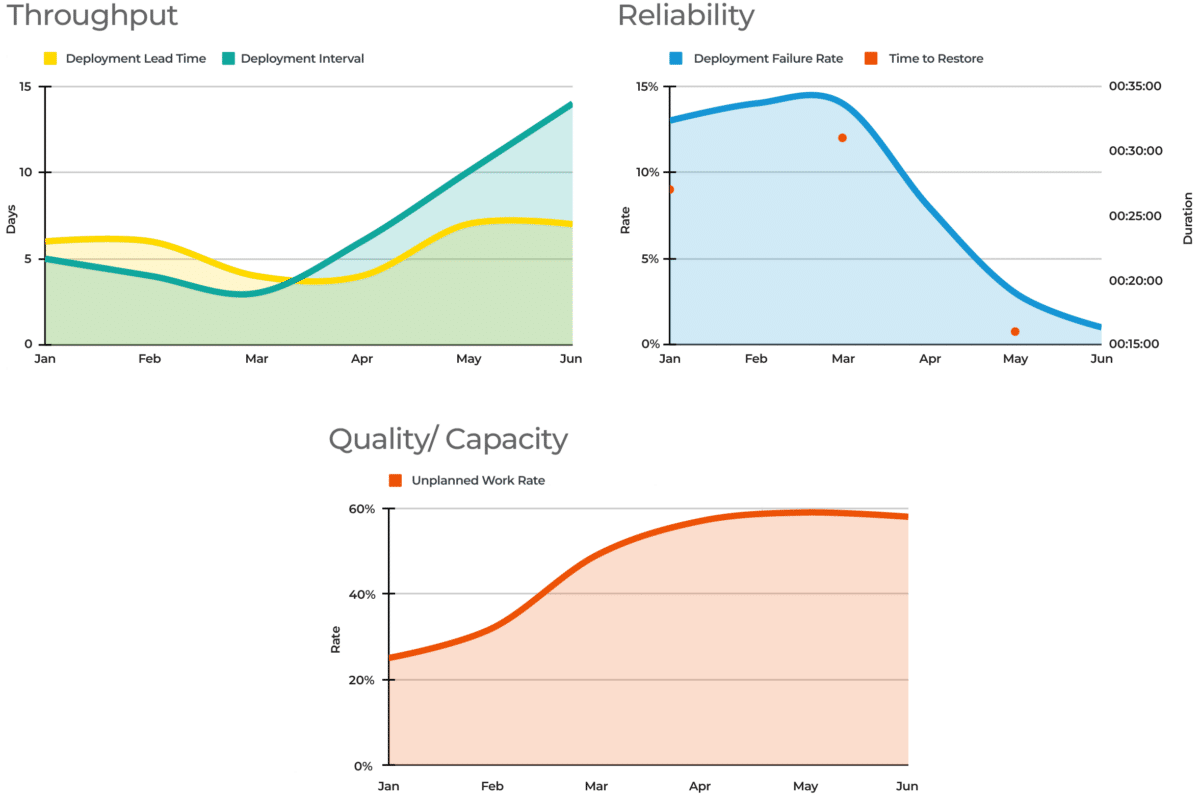Our Thinking Fri 23rd June, 2023
How to win at delivery assurance with DORA metrics
I speak with customers and consultants across the Equal Experts network, to help our customers solve scaling problems and achieve business agility. One topic that often comes up is delivery assurance, and it’s easy to get it wrong. Our preference is to automate and visualise the DORA metrics in a services portal, and use trends to identify assurance needs.
Delivery assurance is about identifying risks, generating insights, and implementing corrective actions, so your delivery teams can deliver business outcomes on time and to a high standard. And it’s challenging when teams are remote-first, in different offices, and/or in different timezones.
The easiest way to get delivery assurance wrong is to measure the wrong thing. Code coverage, story points, and velocity are good examples. They’re easy to implement (which might explain their popularity), but they’re team outputs rather than value stream outcomes. They’re unrelated to user value, offer limited data, and can be gamed by teams incentivised to over-report progress. People change how they behave based on how they’re measured.
At Equal Experts, our delivery assurance advice is the same whether you’ve got 1, 10, or 100 teams:
- Automate the DORA metrics
- Visualise the data in a services portal
- Use trends to identify assurance needs
I once worked in a UK government department with 60 teams in 4 offices. In a meeting, I asked senior managers to write down which teams they were concerned about, and then showed them a new services portal with the DORA metrics. The data highlighted two teams quietly trending downwards, which nobody had written down. Corrective actions were adopted by the teams, and the customer was delighted with our delivery assurance. This is covered in-depth in a public conference talk, which you can see here.
Automate the DORA metrics
The Accelerate book by Dr. Nicole Forsgren et al is a scientific study of IT delivery. It includes the DORA metrics – deployment frequency, deployment lead time, deployment fail rate, time to restore, and rework rate. They’re a great fit for delivery assurance because they’re value stream outcomes, statistically significant performance predictors, and interdependent for success. For example, you can’t rapidly deliver features without a short lead time, and that needs a high standard of technical quality, and that’s implied by a low rework rate.
We recommend the DORA metrics to our customers. We usually expand rework rate into unplanned work rate, so it can include ad hoc value demand as well as failure demand. That gives us an idea of team capacity as well as technical quality. In our experience, it’s better to measure unplanned work than planned work, because the latter is often over-reported. Again, people change how they behave based on how they’re measured!
We automate these metrics for live services with monthly measurements. There are plenty of implementation routes. A live runtime could be EKS or Cloud Run, a system of record could be ServiceNow or Fresh Service, and a ticketing system could be Jira or Trello.

If you don’t have any live services yet, we’d advise frequent deployments of your in-development services into a production environment sealed off from live traffic, and still using these same metrics. And if you aren’t able to do that, it’s still worth measuring unplanned work rate, as it tells you how much time your teams are actually building planned features, versus fixing defects and reworking features without user feedback. That’s always good to know.
Visualise the data in a services portal
A services portal is a dynamic knowledge base for your organisation. It’s a central directory of teams, services, telemetry, change requests, deployments, incidents, and/or post-incident reviews. It replaces all those documents, spreadsheets, and wiki pages that quickly fall out of date.
You might know this as a developer portal from Spotify Backstage, a popular open-source framework for building portals. We’re fans of Backstage, and prefer to talk about services portals to emphasise knowledge bases are for everybody, not just engineers.
Delivery assurance can be implemented in your services portal. It can suck out all the necessary data from your version control system, system of record, ticketing system, and live runtime. Each service page can include DORA metrics, so you can see if a service is trending in the right direction. Those metrics can also be aggregated on each team page. Here’s what those DORA metrics might look like.

Yet again, people change how they behave based on how they’re measured! Always put the DORA metrics for one service or team on one page. Don’t put metrics for two services or two teams on one page. You’re encouraging teams to continuously improve based on their own efforts, not compete against other teams with different contexts and constraints.
Use trends to identify assurance needs
Visualising the DORA metrics in a services portal brings delivery assurance to life. Different team and service pages will show which teams are continuously improving, and which teams are unwittingly sliding in the wrong direction. You’ll understand where investing additional time and effort can put teams back on the right track.
Metrics tell you where to find the most valuable stories, not what the stories are. The above graphs show a delivery team where throughput and unplanned work are worsening, and failure rate is improving. But the metrics don’t explain why this is, and there’s plenty of potential reasons – a slowdown in planned features, an increase in test environments, or a new hard dependency. It’s important to listen to teams with assurance needs, and understand their situation in detail.
A Developer Experience (DevEx) team is a logical choice to own a services portal and its DORA metrics. They can also consult with teams to understand their assurance needs, and offer assistance where required. It’s a supportive, broad role that is best suited to expert practitioners who’ve previously worked on delivery teams in the same organisation.
Conclusion
Delivery assurance is important, and it’s easy to get it wrong by measuring team outputs. The DORA metrics by Dr. Nicole Forsgren et al are statistically significant predictors of IT performance, and it’s relatively straightforward to automate their measurements and visualise them in a services portal. It’s then possible to see at a glance which teams are headed in the wrong direction, and offer them assistance from expert practitioners in a Developer Experience (DevEx) team.



